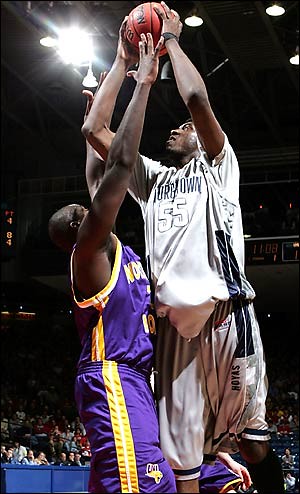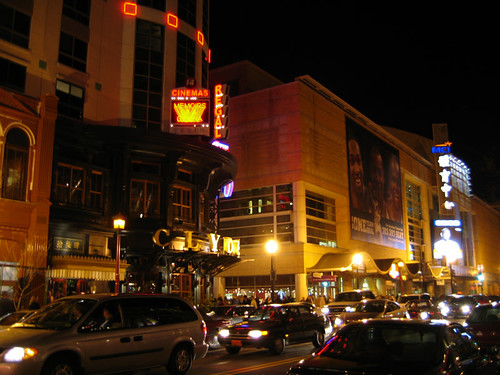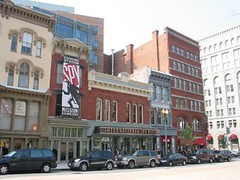Solving sprawl with basketball

Posted January 19, 2008 at 3:23AM
 Tomorrow I’ll be at Washington’s downtown sports arena, the Verizon Center, to cheer on all-American Roy Hibbert and my Georgetown Hoyas as they take on Notre Dame.
Tomorrow I’ll be at Washington’s downtown sports arena, the Verizon Center, to cheer on all-American Roy Hibbert and my Georgetown Hoyas as they take on Notre Dame.
What does this have to do with smart growth? Plenty.
Ten years ago, the area that is today the Penn Quarter, the trendiest part of our city, was a run-down, forgotten part of Washington’s old downtown. Littered with vacant lots and buildings, it was where drug traders went about their business and few outsiders ventured after dark. Today, the whole area is transformed: new and reonovated office buildings line the streets, hotels and new restaurants are packed, a stroller can take advantage of shops and galleries galore, and new apartments and condos are sprouting up. To me it feels like one of the better parts of Manhattan more than like DC. The Penn Quarter is attracting life inward to the central city, a potent counterforce to the sprawl that has dominated regional development patterns for so long.
A lot of this never would have happened, or wouldn’t have happened nearly as well and as quickly, but for the Verizon Center, a one-million-square-feet, glass and stone, 20,000-seat multiuse sports arena that is home not only to Georgetown basketball but also to the Washington Wizards (NBA), Capitals (NHL), and Mystics (WNBA) and, about a week or so ago, Hannah Montana herself. (Well, not entirely; seems like there was a body double for part of Hannah’s show and word got out. Oops.)
Local hero
For this, we owe a huge debt of thanks to a genuine local hero: in 1973, Abe Pollin, the longtime owner of two of Washington’s professional sports franchises—the Wizards and the Capitals (the Caps’ majority ownership has since been transferred to Ted Leonsis)—built the teams’ previous home in the Maryland suburbs. The Capital Centre (later named USAir Arena) was a typical suburban facility, surrounded by a huge concrete parking lot and accessible only by car. It was a nightmare to get to and from. When it turned 20, Pollin decided it was time to build a new, state-of-the-art facility.

Maryland and Virginia officials approached Pollin with lucrative deals, offering large public subsidies for the new arena. But he wanted to build in downtown Washington. That was a bold move: in the early 1990s, Washington was in bad financial shape. Suffering from a lingering perception of crime, the city still had a dicey reputation among many suburban fans of the two teams. Still, Pollin placed his bets on the downtown location. In doing so, he was not only guided by a forward-looking business sense, telling him that better times were ahead for Washington, but also by a genuine desire to help the city: “this city needed someone to step forward—I felt that I was that guy. As owner of two sports teams, I realized that I was in a unique position to help turn this city around.”
There were discussions of a potential subsidy from the city, and the city did donate the land, but the city’s numbers were far from competitive with those in the suburbs. Pollin went ahead anyway, and built the arena with his own money.
Once the city and Pollin reached a final agreement in 1996, construction proceeded quickly. It took only 19 months to build the Verizon (nee MCI) Center—a record for a facility of its size—even with such challenges as building above a multilevel Metro rail transit station and having to reroute a high-security communication line serving the White House at a cost of $4 million.
Getting there is a snap
Although some suburbanites worried initially about safety at the new location, the teams have flourished in the downtown location. Weekday games at the Verizon Center typically begin at 7:00 or 7:30 pm, encouraging downtown employees (including yours truly, on foot) to head directly to the games after work.
 The Verizon Center’s location is its greatest asset. It is close not only to downtown businesses, but also to Washington’s convention center, and it is within walking distance of the National Mall and its world-class galleries, museums, and historic and civic monuments. The newly renovated Smithsonian American Art Museum is located only one block to the west; Chinatown offers restaurants to the north. Both the flag atop the White House and the statue of Freedom on the Capitol dome are visible from the Verizon Center, giving the arena a distinctly Washingtonian identity.
The Verizon Center’s location is its greatest asset. It is close not only to downtown businesses, but also to Washington’s convention center, and it is within walking distance of the National Mall and its world-class galleries, museums, and historic and civic monuments. The newly renovated Smithsonian American Art Museum is located only one block to the west; Chinatown offers restaurants to the north. Both the flag atop the White House and the statue of Freedom on the Capitol dome are visible from the Verizon Center, giving the arena a distinctly Washingtonian identity.
It is particularly significant to smart growth that the Verizon Center is the focal point of an extensive and heavily used regional public transportation system. The arena sits directly above Metrorail’s Gallery Place subway station, where the yellow, red, and green lines meet, and it is only a couple of blocks from stations that serve the blue and orange lines. An estimated 60 to 80 percent of the audience at large Verizon Center events uses public transportation, according to several surveys—an amount that surpassed expectations. In fact, Metro generally runs extra trains on game nights. The arena’s location helps to eliminate thousands of automobile trips at every game, reducing global warming emissions and providing a major environmental benefit for a region with significant air pollution. Even patrons who drive can typically drive shorter distances than with the old arena because of the Verizon’s central location.
The place to be
The Verizon Center was built on land that had once been home to a vibrant downtown shopping area, but which had fallen into neglect after the riots following the 1968 murder of Martin Luther King, Jr., sent businesses fleeing to the suburbs. Although downtown had begun to rebound in the 1980s, most of the new development was farther west, leaving the old downtown retail district derelict. You’d never know it now.
Abe Pollin’s decision to build his new arena there dramatically boosted investors’ confidence in the surrounding area. A business improvement district was formed to create an attractive and sustainable business environment. These developments took place in the midst of a period of strong local and national economic growth, and everything fell into place.
 The Verizon Center is now 10 years old, and Abe Pollin is 80. He spent $220 million in 1990s money to make it happen and, since opening, the arena has served some 24 million customers, helped spur over $6 billion of surrounding smart-growth redevelopment, and hosted the Hoyas on their run last year to the Big East championship and the Final Four.
The Verizon Center is now 10 years old, and Abe Pollin is 80. He spent $220 million in 1990s money to make it happen and, since opening, the arena has served some 24 million customers, helped spur over $6 billion of surrounding smart-growth redevelopment, and hosted the Hoyas on their run last year to the Big East championship and the Final Four.
I like those numbers, especially the last one.
The remainder of this post was added on edit, November 25, 2009:
Abe Pollin passed away on November 24, 2009 at the age of 85. In addition to his influence on downtown revitalization, the scope of his civic and charitable work for the DC area was considerable. Here are some excerpts from Peter Perl's obituary of Mr. Pollin in The Washington Post:
"Mr. Pollin, through his indomitable drive and fierce devotion to his adopted home town, left his imprint on the city as no other sports owner or businessman has done. In addition to building thousands of units of housing for a range of incomes, he was the pillar of countless charitable and civic efforts . . .
"Former D.C. mayor Anthony A. Williams said the city benefited greatly from Mr. Pollin's largess, including small projects such as endowing a Boys and Girls Club . . .
"He fought through [the pain of losing his only daughter, Linda] in part by building the Linda Pollin Memorial Housing Project in Southeast Washington, with three- and four-bedroom apartments to accommodate large families . . .
"Mr. Pollin was well known for his philanthropy, which touched global efforts such as UNICEF, while never forgetting local causes such as the I Have a Dream Foundation. He championed improving the lives of children, considering it an obligation of those who could afford to do so, and his contributions over the years were believed to be in the multiple millions . . .
"Mr. Pollin used some of the first racially integrated construction crews in the region in the 1950s . . .
"In 2002, Mr. Pollin and his wife established the Pollin Prize, a $200,000 annual award for pediatric research. The first recipients were four scientists who were rewarded for their pioneering research work on oral rehydration therapy, an inexpensive means to combat diarrhea caused by malnutrition . . .
"After Sept. 11, 2001, Mr. Pollin led several efforts to aid the victims and families of the terrorist attack on the Pentagon. He put his company name to one of them, an educational fund benefiting the children who lost a parent or guardian in the attack. Abe and Irene Pollin made the first donation of $100,000 . . ."
Abe Pollin was honored for his efforts by the DC-based Coalition for Smarter Growth, and the downtown arena was cited as a success story in Profiles of Business Leaders in Smart Growth (see page 68).
(Credit where it’s due: Many thanks to Jutka Terris, my former colleague and very able coauthor of Solving Sprawl, from whom I borrowed language for this piece.)